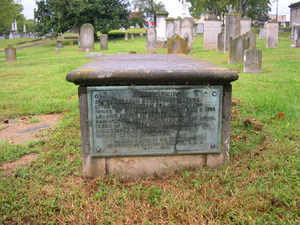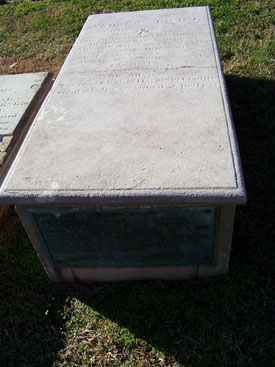|
Unidentified Newspaper Descendants of Andrew Ewing To Unveil Marker at Grave Ceremonies Wednesday Afternoon at City Cemetery Will Also Commemorate Signing of Cumberland Compact. Mrs. Albert G. Ewing III is today announcing the unveiling of a bronze tablet on the tomb of Andrew Ewing, of first Clerk of the Davidson County Court. The celebration is to take place at the City Cemetery, at 1:30 o’clock on Wednesday afternoon, May 1, anniversary of the signing of the Cumberland Compact in 1780, and also of the death of one of its signers, Andrew Ewing, in 1813, and of his son, Nathan (Also Clerk) in 1831. The tablet made possible by the donations from his many descendants in Tennessee, Mississippi, Illinois, and other states, will list Andrew Ewing’s important activities in the Nashborough settlement and later in Davidson County. Research into the written records of the early days reveals many interesting and enlightening items not to be found in published volumes. Among these may be mentioned items purchased by Andrew Ewing in the years 1793-94, in Howell Tatum’s account book, which is still in existence. Some of these articles were specified for various members of Andrew’s family. Andrew Ewin’s name, written in his own hand-writing, is found on the fly-leaf of John Buchanan’s Book of Arithmetic, which is dated June 20, 1781. It is written between the printed lines of the newspaper used to stiffen the buckskin cover of the book, which is decorated on the title page with flower sketches. It will be noted that the first signature of the Clerk, subscribing to the Cumberland Compact in 1780, was that of Andrew Ewin as his name is also spelled in John Buchanan’s Book, and (the historian, Putnam, asserts) through the years previous to the first meetings of the Court of Common Pleas and Quarter Sessions, on October 6, 1783. The first page of the original earliest Minute Book, containing the records of the newly formed Court, finds a changed spelling of the name, with a final “g” added – Andrew Ewing – which is continued thru his last signature as Clerk, thirty years later. All of the early historians, Putnam, Clayton, Gilmore, and the more recent ones copying the statements based on documents now irretrievably lost, have stated that most of James Robertson’s state papers were written in Andrew Ewing’s beautifully flowing handwriting, which are said to have had strokes and lines so delicate that a magnifying glass was used in copying them. The few existing documents signed by him, outside of the record books at the courthouse are highly treasured by his descendants in this county. Several of these papers were displayed at the Pioneer Exhibit held in one of Loveman’s Fifth avenue show windows, April 26-28. It is interesting to know that some of Andrew Ewing’s personal property, articles in his daily use, are known to be yet in existence. A copper tea-kettle, and a delicate cup and saucer brought from Ireland and later to Nashville on a flat-boat, are now in the possession of a descendant in Bristol, Va., while another relative in Alabama only recently witnessed the destruction by fire of a History of Europe, belonging to Andrew Ewing, and a Spanish dictionary, undoubtedly used by him in studying the Spanish intrigue and conspiracy of Alexander McGillivray, Creek Indian chief. The importance of Andrew Ewing’s presence in, and service to the Nashborough settlement, unfortunately has not been realized to the fullest extent. He was fearless as a pioneer, fun-loving as a comrade, authoritative as an arm of the law, intelligent as a counselor, provident as a father, generous as a father, “proverbially good, honest and charitable,” as his tombstone testifies. He was buried in 1813 on a tract of land, which he had purchased from Samuel Bell in 1800. This land passed through three generations of the Ewing name, before being sold to other persons. The family burying ground, and a quarter-acre of ground surrounding it, were “reserved forever,” in the recorded deeds to the property; but this did not prevent the removal of numbers of monuments, the mutilation of others, or further desecration of the land. Therefore the tomb of Andrew Ewing, with the soil beneath and the broken stones formerly covering the graves of his wife, Susannah, his son Nathan, and several infant children, have been removed to the City cemetery for preservation. It is there that the ceremonies will take place on May 1 to honor the memory of this patriot of the Revolution |
After 2009 Restoration Nashville Banner Ewing Descendants Unveil Marker The memory of Andrew Ewing, the first County Court Clerk of Davidson County, native of Virginia and leader in the preservation of Nashborough, which later became Nashville, was perpetuated Wednesday when a bronze plaque was unveiled at his grave in the City Cemetery. The unveiling was part of commemoration exercises marking the signing of the Cumberland Compact at Fort Nashborough 155 years ago yesterday. Douglas Wright, Jr., a descendant of the pioneer Ewing, is shown placing a wreath on the tomb. With him are Roy Ewing and Albert Gallatin Ewing, all great-great-great-great-grandsons of the pioneer. Andrew Ewing III, namesake of Andrew Ewing, is seen at the right, and other relatives are seen at the grave. Printed on the tablet dedicated to his memory are the words: “Andrew Ewing Son of William Ewing—Ann Shannon. Lived in Rockingham Co., Va. 1742-1780. Signer of Cumberland Compact, May 1, 1780. Leading Figure in Preservation of Nashborough Settlement and Nearby Forts. Clerk of Government of Notables, 1783. Ambassador to Chief M’Gillivray. Patriot of the Revolution. Marker Placed by his Descendants, Sponsored by Campbell Chapter, D.A.R. May 1, 1935.” CLICK HERE for information on Ewing family prepared for a family tour on August 18, 2018 by Fletch Coke |
|
|
|



